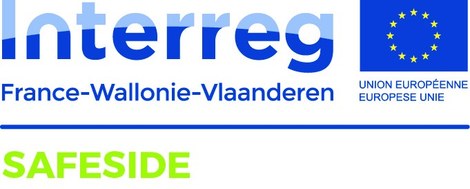Interreg France-Wallonie-Vlaanderen - SAFESIDE
Interreg France-Wallonie-Vlaanderen
The project deals with the development of analysis equipment that can be used to measure from a distance toxic gases that are released in fires or gas leaks. The project is coordinated by MULTITEL (Mons) and has as partners the University of Mons, the Université du Littoral Côte d’Opale, the University of Reims and Ghent University. This is a 3.5 year long project.
- French and Dutch summary below -
Description of the project

Objectives
- The development of an optical parametric oscillator based system that allows line of sight spectroscopic analysis over a distance up to 200 m
- The development of miniaturized sensor systems that allow to be mounted on a drone that flies over the scene and does a real-time mapping of gas concentrations in the area.
Role of Ghent University
The Photonics Research Group of Ghent University is in charge of developing a chip-scale spectroscopic sensor that can be mounted on a drone. This involves the realization of the silicon photonic chip with integrated laser sources and detectors, as well as the read-out electronics around the sensor.
Dutch summary
De doelstelling van het project is de ontwikkeling van nieuwe oplossingen voor de spectroscopische karakterisatie en detectie, zowel vanop afstand als door middel van draagbare instrumentatie, van gassen die vrijkomen bij brand of bij gaslekken op industriële sites. Wanneer er een incident is op een site waar mogelijks schadelijke of dodelijke gassen vrijkomen, is het niet eenvoudig voor de interventiediensten om de situatie in te schatten. Mogelijks worden gevaren –zowel voor de interventiediensten als voor de lokale bevolking- onderschat of verkeerd ingeschat, hetgeen desastreuze gevolgen kan hebben. Daarom is er nood aan toestellen die toelaten om de situatie beter in te schatten, zowel wat betreft de vrijgekomen gassen als hoe die gassen zich verplaatsen, dit vooral wanneer het incident plaats vindt in een dicht bevolkt gebied.
In het labo bestaan er technieken die toelaten om de samenstelling van een gas en de concentratie van de samenstellende delen te meten, en dit op basis van spectroscopische technieken waarbij de absorptie van een lichtbundel wordt gemeten wanneer die door het gas onder studie propageert. Dergelijke systemen laten toe om belangrijke gasmolecules die kunnen vrijkomen bij een incident (gaslek, brand), zoals HCl, CH4, BF3, NOx, SOx en andere te detecteren.
Het idee achter SAFESIDE is om de technieken die vandaag de dag in het labo beschikbaar zijn te transfereren naar het werkveld waar ze gebruikt kunnen worden door interventiediensten voor het inschatten van de ernst van situaties.
Twee types systemen zullen hierbij ontwikkeld worden : een eerste systeem dat toelaat om gassamenstelling te meten van op afstand (orde 200m). Een tweede systeem is een ultra-compact systeem dat draagbaar is en daardoor gemonteerd kan worden op een drone die boven de rampvlek vliegt en data doorstuurt naar een centrale. Alternatief kunnen deze draagbare sensoren ook meegenomen worden door de interventiediensten wanneer ze de rampplek betreden. Testcampagnes zullen worden georganiseerd ten einde de functionaliteit en robustheid van de meetsystemen te evalueren (afhankelijk van het rampscenario, types gassen die vrijkomen, meteorologische omstandigheden, etc.).
Om dit werk tot een goed einde te brengen zal het essentieel zijn om samenwerking over de grenzen heen mogelijk te maken, aangezien aan beide kanten van de grens groepen actief zijn met een sterk track record in dit veld, gaande van het ontwerp van de sensoren, over de specificatie en validatie van dergelijke instrumenten. De resultaten van dit project zullen ook aan de buitenwereld gecommuniceerd worden, teneinde op die manier valorizatie van de ontwikkelde technologie na te streven.
French summary
L’objectif du projet SAFESIDE est de développer de nouvelles solutions de caractérisation spectroscopique à distance et portables pour détecter la nature de gaz dans l’air avec en particulier l’application de la mesure des fumées d’incendie ou de rejets non contrôlés sur des sites à risque ou suite à un accident lors du transport d’une substance dangereuse. Lors d’un accident sur un site dangereux contenant des substances chimiques potentiellement toxiques, les conditions d’intervention ne sont pas simples pour les équipes de terrain. Il n’est pas possible d’intervenir en connaissance de tous les dangers présents et par conséquent d’établir un plan d’intervention adéquat aussi bien pour le personnel intervenant que pour la population locale. Il faut alors pour cela des outils permettant de caractériser les substances et également de mesurer les déplacements des masses d’air afin de prévenir les populations locales de risques potentiels de part et d’autre de la frontière. Il existe des solutions de spectroscopie en laboratoire qui montrent qu’il est possible de mesurer des composés chimiques que l’on peut retrouver généralement dans des émanations accidentelles de gaz sur des sites à risques comme le HCl, NH3, HF, BF3, NOx, SOx ou autres. Afin d’atteindre cet objectif, le projet SAFESIDE visera à amener ces techniques de laboratoire qui sont aujourd’hui disponibles sur le territoire transfrontalier vers le terrain au travers d’un outil d’aide à l’intervention du personnel spécialisé. A l’issue du projet nous souhaitons disposer de systèmes qui soient transportables et permettent l’analyse de gaz à courte distance et à des distances de l’ordre de 200 mètres sans contact. Les systèmes auront été validés par des campagnes de tests poussées qui permettront de déterminer leur robustesse en fonction du scénario de l’accident (type de composés en présence, conditions météorologiques, etc).
Contact
Prof. Gunther Roelkens
Department of Information Technology
Phone number: +3292648930
E-mail: gunther.roelkens@UGent.be
Avec le soutien du Fonds européen de développement régional – Met steun van het Europees Fonds voor Regionale Ontwikkeling
